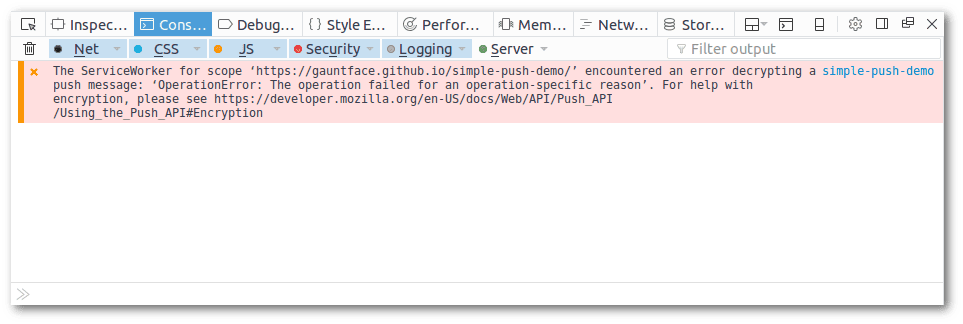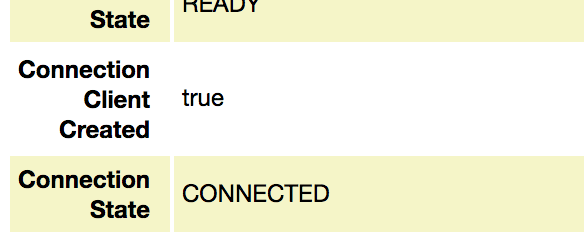When you hit an issue with web push, it can be difficult to debug the issue or find help. This doc outlines some of the common issues and what you should do if you've found a bug in Chrome or Firefox.
Before we dive into debugging push, you may be hitting issues with debugging service workers themselves, the file not updating, failing to register or generally just unusual behavior. There is an awesome document on debugging service workers that I strongly recommend checking out if you are new to service worker development.
There are two distinct stages to check off when developing and testing web push, each with its own set of common issues / problems:
- Sending a Message: Make sure that sending messages is successful.
You should be getting a 201 HTTP code. If you aren't :
- Check for Authorization Errors: If you receive an authorization error message see the Authorization Issues section.
- Other API Errors: If you receive a non-201 status code response, see the HTTP Status Codes section for guidance on the cause of the issue.
- Receiving a Message: If you're able to send a message successfully,
but the message is not received on the browser:
- Check for Encryption Issues: See the Payload Encryption Issue Section.
- Check for Connection Issues: If the problem is on Chrome, it may be a connection. See Connection Issues section for more info.
If you aren't able to send and receive a push message and the relevant sections in this doc aren't helping debug the problem then you may have found a bug in the push mechanism itself. In this case, refer to the Raising Bug Reports section to file a good bug report with all the necessary information to expedite the bug fixing process.
One thing I'd like to call out before we start is that Firefox and the Mozilla AutoPush Service have great error messages. If you get stuck and are not sure what the problem is, then test in Firefox and see if you get a more helpful error message.
Authorization issues
Authorization issues are one of the most common issues developers hit when starting out with web push. This is normally a problem with the configuration of a site's Application Server Keys (a.k.a. VAPID keys) .
The easiest way to support push in both Firefox and Chrome is to supply an
applicationServerKey in the subscribe() call. The down side is that
any discrepancy between your front end and server's keys will result in an
authorization error.
On Chrome and FCM
For Chrome, which uses FCM as a push service, you'll receive an
UnauthorizedRegistration response from FCM for a range of different
errors, all involving the application server keys.
You'll receive an UnauthorizedRegistration error in any of the following
situations:
- If you fail to define an
Authorizationheader in the request to FCM. - Your application key used to subscribe the user doesn't match the key used to sign the Authorization header.
- The expiration is invalid in your JWT, i.e. the expiration exceeds 24 hours or the JWT has expired.
- The JWT is malformed or has invalid values.
The full error response looks like this:
<html>
<head>
<title>UnauthorizedRegistration</title>
</head>
<body bgcolor="#FFFFFF" text="#000000">
<h1>UnauthorizedRegistration</h1>
<h2>Error 400</h2>
</body>
</html>
If you receive this error message in Chrome, consider testing in Firefox to see if it'll provide more insight to the problem.
Firefox and Mozilla AutoPush
Firefox and Mozilla AutoPush provide a friendly set of error messages for
Authorization issues.
You'll also receive an Unauthorized error response from
Mozilla AutoPush if the Authorization header is not included in your push
request.
{
"errno": 109,
"message": "Request did not validate missing authorization header",
"code": 401,
"more_info": "http://autopush.readthedocs.io/en/latest/http.html#error-codes",
"error": "Unauthorized"
}
If the expiration in your JWT has expired, you'll also receive an
Unauthorized error with a message that explains that the token has
expired.
{
"code": 401,
"errno": 109,
"error": "Unauthorized",
"more_info": "http://autopush.readthedocs.io/en/latest/http.html#error-codes",
"message": "Request did not validate Invalid bearer token: Auth expired"
}
If the application server keys are different between when the user was
subscribed and when the Authorization header was signed, a Not Found
error will be returned:
{
"errno": 102,
"message": "Request did not validate invalid token",
"code": 404,
"more_info": "http://autopush.readthedocs.io/en/latest/http.html#error-codes",
"error": "Not Found"
}
Lastly, if you have an invalid value in your JWT (for example if the "alg" value is an unexpected value), you'll receive the following error from Mozilla AutoPush:
{
"code": 401,
"errno": 109,
"error": "Unauthorized",
"more_info": "http://autopush.readthedocs.io/en/latest/http.html#error-codes",
"message": "Request did not validate Invalid Authorization Header"
}
HTTP status codes
There are a range of issues that can result in a non-201 response code from a push service. Below is a list of HTTP status codes and what they mean in relation to web push.
| Status Code | Description |
|---|---|
| 429 | Too many requests. Your application server has reached a rate limit with a push service. The response from the service should include a 'Retry-After' header to indicate how long before another request can be made. |
| 400 | Invalid request. One of your headers is invalid or poorly formatted. |
| 404 | Not Found. In this case you should delete the PushSubscription from your back end and wait for an opportunity to resubscribe the user. |
| 410 | Gone. The subscription is no longer valid and should be removed from your back end. This can be reproduced by calling `unsubscribe()` on a `PushSubscription`. |
| 413 | Payload size too large. The minimum size payload a push service must support is 4096 bytes (or 4kb). Anything larger can result in this error. |
If the HTTP status code is not in this list and the error message is not helpful, check the Web Push Protocol spec to see if the status code is referenced along with a scenario of when that status code can be used.
Payload encryption issue
If you can successfully trigger a push message (i.e. send a message to a web push service and receive a 201 response code) but the push event never fires in your service worker, this normally indicates that the browser failed to decrypt the message it received.
If this is the case, you should see an error message in Firefox's DevTools console like so:

To check if this is the issue in Chrome, do the following:
- Go to about://gcm-internals and click the "Start Recording" button.

- Trigger a push message, and look under the "Message Decryption Failure Log".

If there is an issue with the decryption of the payload, you'll see an error
similar to the one displayed above. (Notice the AES-GCM decryption failed
message in the details column.)
There are a few tools which may help debug encryption if this is your issue:
Connection issue
If you aren't receiving a push event in your service worker and you aren't seeing any decryption errors, then the browser may be failing to connect to a push service.
In Chrome, you can check whether the browser is receiving messages by examining
the 'Receive Message Log' (sic) in about://gcm-internals.

If you aren't seeing the message arrive in a timely fashion, then make sure that
the connection status of your browser is CONNECTED:

If it's not 'CONNECTED', you may need to delete your current profile and create a new one. If that still doesn't solve the issue, please raise a bug report as suggested below.
Raising bug reports
If none of the above helps with your issue and there is no sign of what the problem could be, please raise an issue against the browser you are having an issue with:
For Chrome, you'd raise the issue here: https://bugs.chromium.org/p/chromium/issues/list For Firefox, you should raise the issue on: https://bugzilla.mozilla.org/
To provide a good bug report, you should provide the following details:
- Browsers you've tested in (e.g. Chrome version 50, Chrome version 51, Firefox version 50, Firefox version 51).
- An example
PushSubscriptionthat demonstrates the problem. - Include any example requests (i.e. content of network requests to a push service, including headers).
- Include any example responses from network requests as well.
If you can provide a reproducible example, either source code or a hosted web site, it often speeds up diagnosing and solving the problem.
Where to go next
- Web Push Notification Overview
- How Push Works
- Subscribing a User
- Permission UX
- Sending Messages with Web Push Libraries
- Web Push Protocol
- Handling Push Events
- Displaying a Notification
- Notification Behavior
- Common Notification Patterns
- Push Notifications FAQ
- Common Issues and Reporting Bugs
